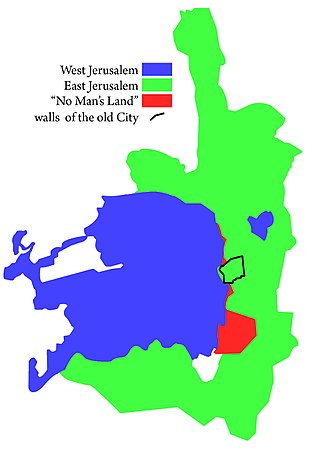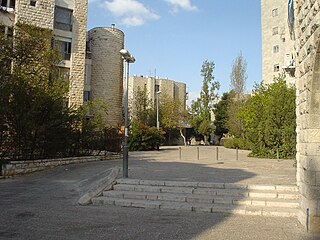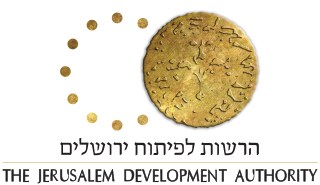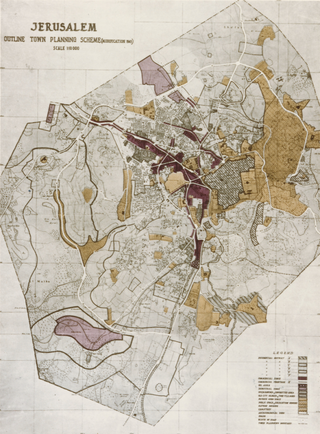
Katamon or Qatamon, officially known as Gonen, is a neighborhood in south-central Jerusalem. It is built next to an old Greek Orthodox monastery, believed to have been constructed on the home and the tomb of Simeon from the Gospel of Luke.

West Jerusalem or Western Jerusalem refers to the section of Jerusalem that was controlled by Israel at the end of the 1948 Arab–Israeli War. As the city was divided by the Green Line, West Jerusalem was formally delineated as the counterpart to East Jerusalem, which was controlled by Jordan. Though Israel has controlled the entirety of Jerusalem since the 1967 Arab–Israeli War, the boundaries of West Jerusalem and East Jerusalem remain internationally recognized as de jure due to their significance to the process of determining the status of Jerusalem, which has been among the primary points of contention in the Arab–Israeli conflict and the Israeli–Palestinian conflict. With certain exceptions, undivided Jerusalem is not internationally recognized as the sovereign territory of either Israel or the State of Palestine. However, recognition of Israeli sovereignty over only West Jerusalem is more widely accepted as a plausible diplomatic position, as the United Nations regards East Jerusalem as part of the Israeli-occupied West Bank.

The Museum of Tolerance Jerusalem is a museum, convention center and entertainment venue in downtown Jerusalem. The museum's construction was controversial due to its intrusion into the Mamilla Cemetery, a millennia-old Muslim burial site.

Mamilla is a neighbourhood of Jerusalem that was established in the late 19th century outside the Old City, west of the Jaffa Gate. Until 1948 it was a mixed Jewish–Arab business district. Between 1948 and 1967, it was located along the armistice line between the Israeli and Jordanian-held sector of the city, and many buildings were destroyed by Jordanian shelling. The Israeli government approved an urban renewal project for Mamilla, apportioning land for residential and commercial zones, including hotels and office space. The Mamilla Mall opened in 2007.

Rehavia or Rechavia is an upscale Jerusalem neighborhood located between the city center and Talbiya. Since its establishment in 1922, the neighborhood has been associated with German-Jewish (yekke) culture and tradition.

David Citadel Hotel is a luxury hotel on King David Street in Jerusalem, across the street from the Mamilla Mall. It has hosted VIPs, global political leaders, business moguls and celebrities, competing with the nearby King David Hotel and the new Waldorf Astoria for the title of "Jerusalem's flagship hotel".

The Stern House, is a preserved and reconstructed historic building in Jerusalem. The house was built in 1877 in Mamilla, one of the original neighborhoods outside the city walls, and was rescued during a major reconstruction of the same neighborhood in the late 20th and early 21st century.

Ma'alot Dafna is an Israeli settlement and a neighborhood in East Jerusalem. It borders the neighborhood of Shmuel HaNavi to the west, Ammunition Hill to the east, Ramat Eshkol to the north and Arzei HaBira to the south.

Mamilla Mall, also called Alrov Mamilla Avenue, is an upscale shopping street and the only open-air mall in West Jerusalem. Located northwest of Jaffa Gate, the mall consists of a 2,000-foot (610 m) pedestrian promenade called Alrov Mamilla Avenue lined by 140 stores, restaurants, and cafes, and office space on upper floors. It sits atop a multi-story parking garage for 1,600 cars and buses, and a bus terminal. Designed by Moshe Safdie and developed by Alrov Properties and Lodgings Ltd. of Tel Aviv, the mall incorporates the facades of 19th-century buildings from the original Mamilla Street, as well as the original structures of the Convent of St. Vincent de Paul, the Stern House, and the Clark House.

Froumine House was the temporary abode of the Israeli Parliament, the Knesset, from 1950 to 1966. The building is at 24 King George Street in downtown Jerusalem. The first to the fifth Knesset sessions were conducted there.

The Jerusalem Development Authority, or JDA, is a joint agency of the Israeli government and the Jerusalem Municipality that works to promote and develop the economy of the city of Jerusalem. The Authority was founded by Uziel Wexler and was established as a statutory corporation under the Jerusalem Development Authority Law 1988. Teddy Kollek was one of the key figures behind its establishment.

The Downtown Triangle is a commercial and entertainment district in central Jerusalem. Measuring 29,000 square metres (310,000 sq ft), the area is bounded by Jaffa Road on the north, King George Street on the west, and Ben Yehuda Street on the southeast. Its vertices are the intersections of Jaffa Road and King George Street, King George and Ben Yehuda Streets, and Ben Yehuda Street and Jaffa Road.

Batei Saidoff is a former courtyard neighborhood in western Jerusalem. Erected by Yitzhak Saidoff, a wealthy Bukharan Jew, in 1911, it was one of a series of courtyard neighborhoods built along Jaffa Road in the late 19th and early 20th centuries, together with Sha'arei Yerushalayim and Ohel Shlomo. In the 2000s the two buildings facing Jaffa Road were evacuated of tenants and redeveloped as upscale shops, and a 23-story luxury residential tower was constructed south of the courtyard.

Sha'arei Yerushalayim is a former courtyard neighborhood in western Jerusalem. It is one of a series of courtyard neighborhoods built along Jaffa Road in the late 19th and early 20th centuries, together with Ohel Shlomo and Batei Saidoff. Today it is considered part of the Mekor Baruch neighborhood.

Ohel Shlomo is a historical courtyard neighborhood in western Jerusalem. It is one of a series of courtyard neighborhoods built along Jaffa Road in the late 19th and early 20th centuries, together with Sha'arei Yerushalayim and Batei Saidoff. Today it is considered part of the Mekor Baruch neighborhood.

Clal Center, also known as Clal Building, is a 15-story office tower and indoor shopping mall on Jaffa Road in Jerusalem. Completed in 1972, it was the first upscale, indoor shopping mall in Jerusalem. Built as part of a plan to revitalize Jaffa Road, it enjoyed a brief period of high occupancy until many tenants relocated to malls and office buildings in new suburbs in the 1990s. It is widely viewed as a commercial and architectural failure.

Knesset Yisrael, also known as Knesset, is the name of a group of three former courtyard neighborhoods in central Jerusalem. Known as Knesset Aleph, Knesset Bet, and Knesset Gimmel, the housing project was planned by the Vaad HaKlali Knesset Yisrael and funded by overseas Jewish donors. The houses were completed in stages from 1892 to 1926. Beneficiaries of the housing were poor Haredi Ashkenazi families and Torah scholars connected to the Central Committee kolel system. Today Knesset Yisrael is part of the Nachlaot neighborhood.

Mahane Yehuda is a historic neighborhood in Jerusalem. Established on the north side of Jaffa Road in 1887, it was planned and managed by the consortium of Swiss-Christian banker Johannes Frutiger and his Jewish partners, Joseph Navon and Shalom Konstrum. By the end of the 19th century, it encompassed 162 homes. Originally occupied by upper middle-class residents, it became a working-class neighborhood beginning in the late 1920s. Today the neighborhood is part of Nachlaot. The Mahane Yehuda Market located across the street was named after the neighborhood.

Mashiach Borochoff House is a historical building located at 64 Jaffa Road in Jerusalem. Built in 1908 in eclectic style, its entrance is covered by an arcade with pointed arches supported by pseudo-Corinthian columns. The gate, in the style of 17th-century Georgian architecture, consists of two pillars connected by ironwork. A lion statue is placed atop each pillar. The house was built by Mashiach Borochoff, a wealthy Bukharan Jewish merchant, as a family residence. In 1947, a year after Borochoff's death, the property was sold to Barclays bank. It has functioned as a bank branch since that time.

Henry Kendall (1903–1983) was a British architect, who worked as an urban planner, in British colonies and former colonies.




















